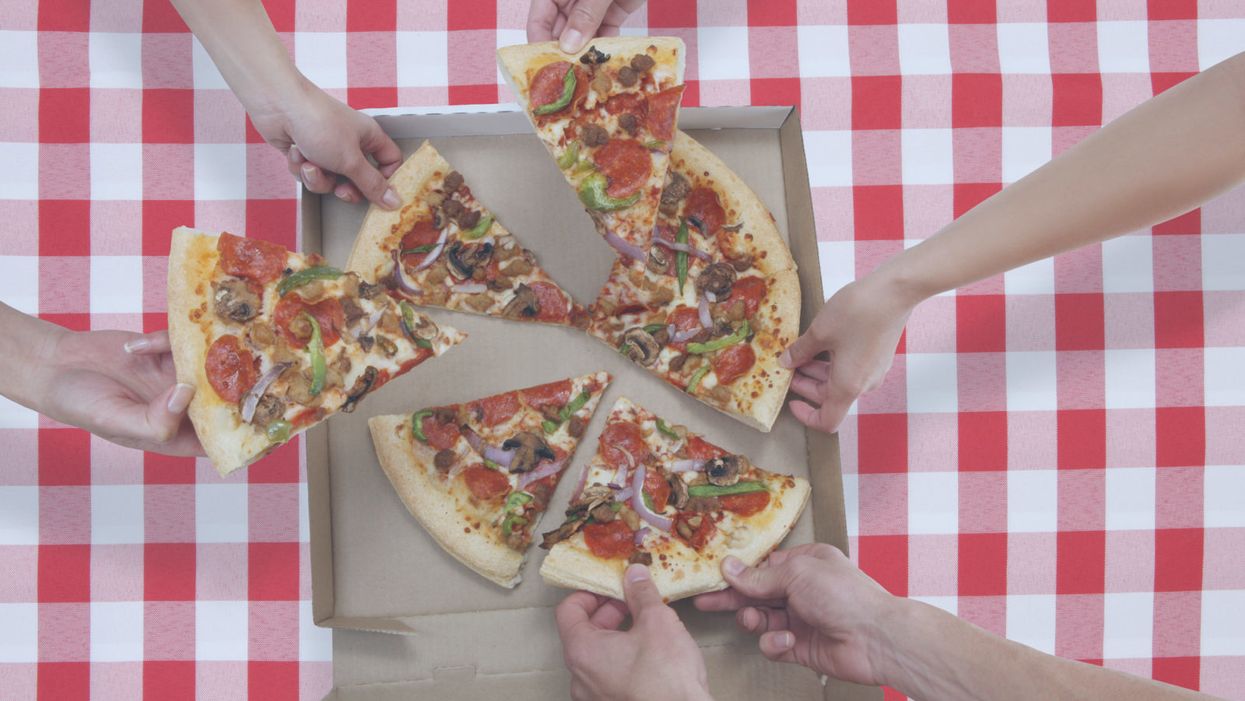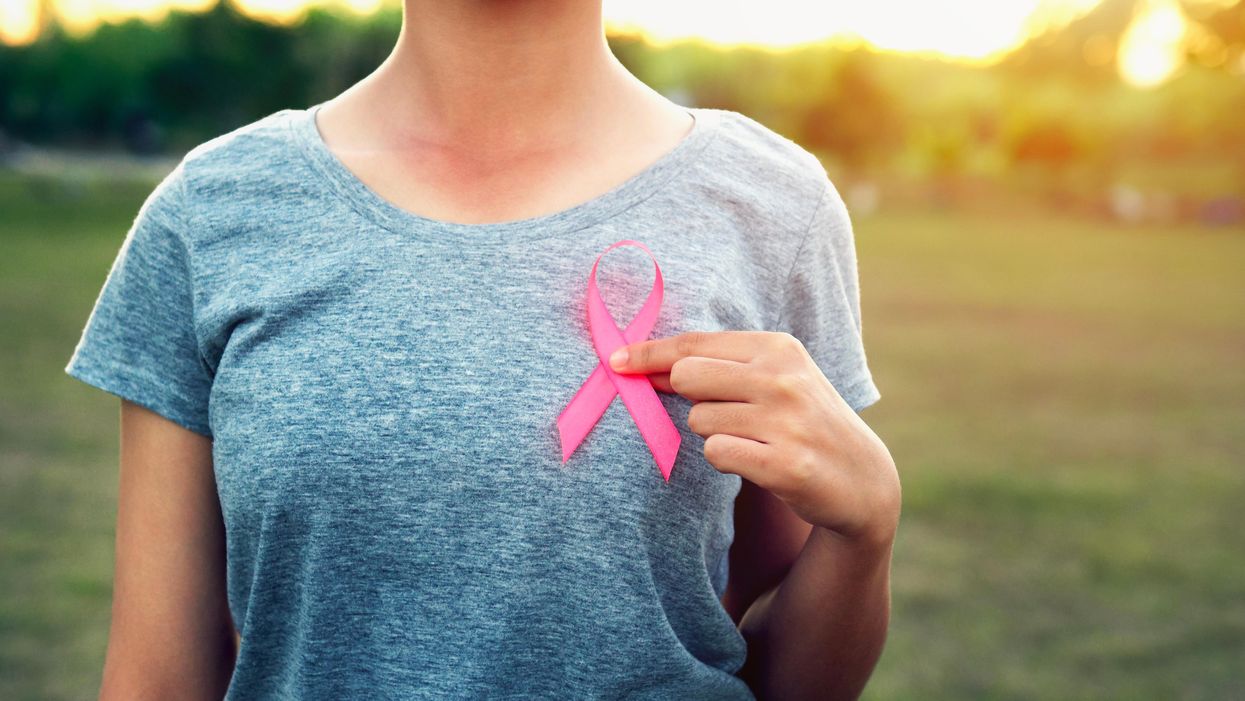Why You Can’t Blame Your Behavior On Your Gut Microbiome

People eating pizza; are they being influenced by their gut microbiome?
See a hot pizza sitting on a table. Count the missing pieces: three. They tasted delicious and yes, you've eaten enough—but you're still eyeing a fourth piece. Do you reach out and take it, or not?
"The difficulty comes in translating the animal data into the human situation."
Your behavior in that next moment is anything but simple: as far as scientists can tell, it comes down to a complex confluence of circumstances, genes, and personality characteristics. And the latest proposed addition to this list is the gut microbiome—the community of microorganisms, including bacteria, archaea, fungi, and viruses—that are full-time residents of your digestive tract.
It is entirely plausible that your gut microbiome might influence your behavior, scientists say: a well-known communication channel, called the gut-brain axis, runs both ways between your brain and your digestive tract. Gut bugs, which are close to the action, could amplify or dampen the messages, thereby shaping how you act. Messages about food-related behaviors could be particularly susceptible to interception by these microorganisms.
Perhaps it's convenient to imagine your resident microbes sitting greedily in your gut, crying for more pizza and tricking your brain into getting them what they want. The problem is, there's a distinct lack of scientific support for this actually happening in humans.
John Bienenstock, professor of pathology and molecular medicine at McMaster University (Canada), has worked on the gut microbiome-behavior connection for several decades. "There's a lot of evidence now in animals—particularly in mice," he says.
Indeed, his group and others have shown that, by eliminating or altering gut bugs, they can make mice exhibit different social behaviors or respond more coolly to stress; they can even make a shy mouse turn brave. But Bienenstock cautions: "The difficulty comes in translating the animal data into the human situation."
Animal behaviors are worlds apart from what we do on a daily basis—from brushing our teeth to navigating complex social situations.
Not that it's an easy task to figure out which aspects of animal research are relevant to people in everyday life. Animal behaviors are worlds apart from what we do on a daily basis—from brushing our teeth to navigating complex social situations.
Elaine Hsiao, assistant professor of integrative biology and physiology at UCLA, has also looked closely at the microbiome-gut-brain axis in mice and pondered how to translate the results into humans. She says, "Both the microbiome and behavior vary substantially [from person to person] and can be strongly influenced by environmental factors—which makes it difficult to run a well-controlled study on effects of the microbiome on human behavior."
She adds, "Human behaviors are very complex and the metrics used to quantify behavior are often not precise enough to derive clear interpretations." So the challenge is not only to figure out what people actually do, but also to give those actions numerical codes that allow them to be compared against other actions.
Hsiao and colleagues are nevertheless attempting to make connections: building on some animal research, their recent study found a three-way association in humans between molecules produced by their gut bacteria (that is, indole metabolites), the connectedness of different brain regions as measured through functional magnetic resonance imaging, and measures of behavior: questionnaires assessing food addiction and anxiety.
Meanwhile, other studies have found it may be possible to change a person's behavior through either probiotics or gut-localized antibiotics. Several probiotics even show promise for altering behavior in clinical conditions like depression. Yet how these phenomena occur is still unknown and, overall, scientists lack solid evidence on how bugs control behavior.
Bienenstock, however, is one of many continuing to investigate. He says, "Some of these observations are very striking. They're so striking that clearly something's up."
He says that after identifying a behavior-changing bug, or set of bugs, in mice: "The obvious next thing is: How [is it] occurring? Why is it occurring? What are the molecules involved?" Bienenstock favors the approach of nailing down a mechanism in animal models before starting to investigate its relevance to humans.
He explains, "[This preclinical work] should allow us to identify either target molecules or target pathways, which then can be translated."
Bienenstock also acknowledges the 'hype' that appears to surround this particular field of study. Despite the decidedly slow emergence of data linking the microbiome to human behavior, scientific reviews have appeared in brain-related scientific journals—for instance, Trends in Cognitive Sciences; CNS Drugs—with remarkable frequency. Not only this, but popular books and media articles have given the idea wings.
It might be compelling to blame our microbiomes for behaviors we don't prefer or can't explain—like reaching for another slice of pizza. But until the scientific observations yield stronger results, we still lack proof that we're doing what we do—or eating what we eat—exclusively at the behest of our resident microorganisms.
In today's episode, Leaps.org interviews Camila dos Santos, a molecular biologist at Cold Spring Harbor Lab, about her research on breasts and what makes them unique compared to any other part of the body.
My guest today for the Making Sense of Science podcast is Camila dos Santos, associate professor at Cold Spring Harbor Lab, who is a leading researcher of the inner lives of human mammary glands, more commonly known as breasts. These organs are unlike any other because throughout life they undergo numerous changes, first in puberty, then during pregnancies and lactation periods, and finally at the end of the cycle, when babies are weaned. A complex interplay of hormones governs these processes, in some cases increasing the risk of breast cancer and sometimes lowering it. Witnessing the molecular mechanics behind these processes in humans is not possible, so instead Dos Santos studies organoids—the clumps of breast cells donated by patients who undergo breast reduction surgeries or biopsies.
Show notes:
2:52 In response to hormones that arise during puberty, the breast cells grow and become more specialized, preparing the tissue for making milk.
7:53 How do breast cells know when to produce milk? It’s all governed by chemical messaging in the body. When the baby is born, the brain will release the hormone called oxytocin, which will make the breast cells contract and release the milk.
12:40 Breast resident immune cells are including T-cells and B-cells, but because they live inside the breast tissue their functions differ from the immune cells in other parts of the body,
17:00 With organoids—dimensional clumps of cells that are cultured in a dish—it is possible to visualize and study how these cells produce milk.
21:50 Women who are pregnant later in life are more likely to require medical intervention to breastfeed. Scientists are trying to understand the fundamental reasons why it happens.
26:10 Breast cancer has many risks factors. Generic mutations play a big role. All of us have the BRCA genes, but it is the alternation in the DNA sequence of the BRCA gene that can increase the predisposition to breast cancer. Aging and menopause are the risk factors for breast cancer, and so are pregnancies.
29:22 Women that are pregnant before the age of 20 to 25, have a decreased risk of breast cancer. And the hypothesis here is that during pregnancy breast cells more specialized, as specialized cells, they have a limited lifespan. It's more likely that they die before they turn into cancer.
33:08 Organoids are giving scientists an opportunity to practice personalized medicine. Scientists can test drugs on organoids taken from a patient to identify the most efficient treatment protocol.
Links:
Camila dos Santos’s Lab Page.
Editor's note: In addition to being a regular writer for Leaps.org, Lina Zeldovich is the guest host for today's episode of the Making Sense of Science podcast.
Lina Zeldovich has written about science, medicine and technology for Popular Science, Smithsonian, National Geographic, Scientific American, Reader’s Digest, the New York Times and other major national and international publications. A Columbia J-School alumna, she has won several awards for her stories, including the ASJA Crisis Coverage Award for Covid reporting, and has been a contributing editor at Nautilus Magazine. In 2021, Zeldovich released her first book, The Other Dark Matter, published by the University of Chicago Press, about the science and business of turning waste into wealth and health. You can find her on http://linazeldovich.com/ and @linazeldovich.
Podcast: The Friday Five Weekly Roundup in Health Research
In this week's Friday Five, learn how to get the benefits of near-death experience; how to tell the difference between good and bad inflammation; how brain shocks can improve memory; how to increase your longevity even without good genes for living longer; and much more.
The Friday Five covers five stories in research that you may have missed this week. There are plenty of controversies and troubling ethical issues in science – and we get into many of them in our online magazine – but this news roundup focuses on scientific creativity and progress to give you a therapeutic dose of inspiration headed into the weekend.
Here are the promising studies covered in this week's Friday Five:
- Not a fan of breathing in micro plastics? New robot noses could help
- You don't need a near-death experience to get the benefits
- How to tell the difference between good and bad inflammation
- Brain shocks for better memory - don't try this at home (yet)!
- A new way to know if your bum back is getting better
The honorable mention for this week's Friday Five: One activity can increase your longevity even without good genes for living longer.

